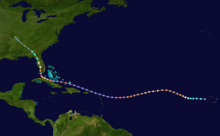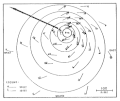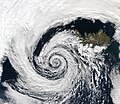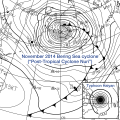Portal:Tropical cyclones
The Tropical Cyclones Portal
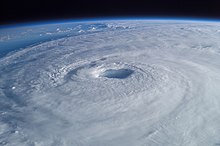
A tropical cyclone is a storm system characterized by a large low-pressure center, a closed low-level circulation and a spiral arrangement of numerous thunderstorms that produce strong winds and heavy rainfall. Tropical cyclones feed on the heat released when moist air rises, resulting in condensation of water vapor contained in the moist air. They are fueled by a different heat mechanism than other cyclonic windstorms such as Nor'easters, European windstorms and polar lows, leading to their classification as "warm core" storm systems. Most tropical cyclones originate in the doldrums, approximately ten degrees from the Equator.
The term "tropical" refers to both the geographic origin of these systems, which form almost exclusively in tropical regions of the globe, as well as to their formation in maritime tropical air masses. The term "cyclone" refers to such storms' cyclonic nature, with anticlockwise rotation in the Northern Hemisphere and clockwise rotation in the Southern Hemisphere. Depending on its location and intensity, a tropical cyclone may be referred to by names such as "hurricane", "typhoon", "tropical storm", "cyclonic storm", "tropical depression" or simply "cyclone".
Types of cyclone: 1. A "Typhoon" is a tropical cyclone located in the North-west Pacific Ocean which has the most cyclonic activity and storms occur year-round. 2. A "Hurricane" is also a tropical cyclone located at the North Atlantic Ocean or North-east Pacific Ocean which have an average storm activity and storms typically form between May 15 and November 30. 3. A "Cyclone" is a tropical cyclone that occurs in the South Pacific and Indian Oceans.
Selected named cyclone -
Hurricane Irma was an extremely powerful and devastating tropical cyclone that was the first Category 5 hurricane to strike the Leeward Islands on record, followed by Maria two weeks later. At the time, it was considered the most powerful hurricane on record in the open Atlantic region, outside of the Caribbean Sea and Gulf of Mexico, until it was surpassed by Hurricane Dorian two years later. It was also the third-strongest Atlantic hurricane at landfall ever recorded, just behind the 1935 Labor Day Hurricane and Dorian. The ninth named storm, fourth hurricane, second major hurricane, and first Category 5 hurricane of the extremely active 2017 Atlantic hurricane season, Irma caused widespread and catastrophic damage throughout its long lifetime, particularly in the northeastern Caribbean and the Florida Keys. It was also the most intense hurricane to strike the continental United States since Katrina in 2005, the first major hurricane to make landfall in Florida since Wilma in the same year, and the first Category 4 hurricane to strike the state since Charley in 2004. The word Irmageddon was coined soon after the hurricane to describe the damage caused by the hurricane.
Irma developed from a tropical wave near the Cape Verde Islands on August 30. Favorable conditions allowed Irma to rapidly intensify into a Category 3 hurricane on the Saffir–Simpson wind scale by late on August 31. The storm's intensity fluctuated between Categories 2 and 3 for the next several days, due to a series of eyewall replacement cycles. On September 4, Irma resumed intensifying, becoming a Category 5 hurricane by early on the next day. Early on September 6, Irma peaked with 1-minute sustained winds of 180 mph (290 km/h) and a minimum pressure of 914 hPa (27.0 inHg). Irma was the second-most intense tropical cyclone worldwide in 2017 in terms of barometric pressure, and the strongest worldwide in 2017 in terms of wind speed. Another eyewall replacement cycle caused Irma to weaken back to a Category 4 hurricane, but the storm re-attained Category 5 status before making landfall in Cuba. Although Irma briefly weakened to a Category 2 storm while making landfall on Cuba, the system re-intensified to Category 4 status as it crossed the warm waters of the Straits of Florida, before making landfall on Cudjoe Key on September 10. Irma then weakened to Category 3 status, prior to another landfall in Florida on Marco Island later that day. The system degraded into a remnant low over Alabama and ultimately dissipated on September 13 over Missouri. (Full article...)
Selected article -
Hurricane Irma was an extremely powerful Cape Verde hurricane that caused extensive damage in the Caribbean and Florida. Lasting from late August to mid-September 2017, the storm was the strongest open-Atlantic tropical cyclone on record and the first Category 5 hurricane to strike the Leeward Islands. Classified as the ninth named storm, fourth hurricane, and second major hurricane of the hyperactive 2017 Atlantic hurricane season, Irma developed from a tropical wave near the Cape Verde Islands on August 30. Favorable conditions allowed the cyclone to become a hurricane on the following day and then rapidly intensify into a major hurricane by September 1 as it moved generally westward across the Atlantic. However, dry air and eyewall replacement cycles disrupted further strengthening, with fluctuations in intensity during the next few days. Irma resumed deepening upon encountering warmer sea surface temperatures, while approaching the Lesser Antilles on September 4. The system reached Category 5 intensity on the following day and peaked with winds of 180 mph (290 km/h) shortly thereafter.
Irma made its first landfall on Barbuda early on September 6 at peak intensity. The hurricane also struck Saint Martin and Virgin Gorda in the British Virgin Islands at Category 5 intensity later that day. Upon clearing the Leeward Islands, the cyclone continued west-northwestward toward the Bahamas. Around the time of landfall on Little Inagua Island early on September 8, Irma weakened to a Category 4 hurricane, after being a Category 5 hurricane for about 60 consecutive hours, the second longest contiguous time period as a Category 5 hurricane on record. Late on September 8, the storm re-intensified to Category 5 southwest of Ragged Island. Irma made landfall near Cayo Romano, Cuba, at that intensity, becoming the first Category 5 hurricane to strike the island since 1924. Although land interaction weakened Irma to a high-end Category 2 hurricane, the system re-intensified to Category 4 status as it crossed the warm waters of the Straits of Florida, before making landfall on Cudjoe Key on September 10. Irma weakened to Category 3 status prior to another landfall in Florida on Marco Island later that day. The system degraded into a remnant low over Alabama, and ultimately dissipated on September 13 over Missouri. (Full article...)
Selected image -

Selected season -

The 1999–2000 South-West Indian Ocean tropical cyclone season was the first on record in which two storms – Leon–Eline and Hudah – struck Mozambique at tropical cyclone intensity, or with maximum sustained winds of at least 120 km/h (75 mph). The most notable storm of the season was Eline, which was the third longest-lasting storm on record in the basin. It lasted for 29 days while traversing the southern Indian Ocean, making the strongest landfall in decades along eastern Madagascar in late February. The storm was the first in a series of three storms that struck the country in early 2000, along with Gloria in March and Hudah in April. Collectively, the three storms killed at least 316 people. The season started on November 1, 1999, and ended for most of the basin on April 30, 2000; for Mauritius and the Seychelles, the season continued until May 15. These dates conventionally delimit the period of each year when most tropical cyclones form in the basin.
Despite the destructive nature of the season, it began later than usual. Cyclone Astride originated toward the end of December, bringing rainfall and gusty winds to northern Madagascar while in the region. In January, Cyclones Babiola and Connie both formed east of Madagascar and took southerly tracks. Connie passed near Réunion island, producing 1,752 mm (69.0 in) of rainfall in the mountainous peaks and killing two people. Eline, the longest lasting storm of the season, struck Mozambique while the country was experiencing its worst flooding in 50 years, collectively causing around 700 deaths and about $500 million in damage. The storm also killed 12 people in Zimbabwe and 21 in South Africa. Just two weeks after Eline struck Madagascar, Tropical Storm Gloria affected the same general region, bringing additional deaths and damage. Cyclone Hudah in April was the strongest storm of the season, reaching peak 10‑minute winds of 220 km/h (140 mph). It caused three deaths in Mozambique, although its effects were worse in Madagascar, where there were 111 deaths. The final storm of the season was Tropical Storm Innocente, which dissipated on April 24. In addition to the named storms, there were four unnamed tropical disturbances or storms, as well as one subtropical cyclone that formed in the southern Mozambique Channel.
(Full article...)Related portals
Currently active tropical cyclones

Italicized basins are unofficial.
- North Atlantic (2024)
- No active systems
- East and Central Pacific (2024)
- No active systems
- West Pacific (2024)
- No active systems
- North Indian Ocean (2024)
- No active systems
- Mediterranean (2024–25)
- No active systems
- South-West Indian Ocean (2024–25)
- No active systems
- Australian region (2024–25)
- No active systems
- South Pacific (2024–25)
- No active systems
- South Atlantic (2024–25)
- No active systems
Last updated: 22:43, 22 November 2024 (UTC)
Tropical cyclone anniversaries

November 23
- 1978 - A powerful cyclone (pictured) struck northeastern Sri Lanka, killing 915 people.
- 1982 - Hurricane Iwa reached its peak intensity with winds of 145 km/h (90 mph) to the southwest of Hawaii. Iwa passed very close to the island of Kauai the next day causing about $200 million in damage.

November 24
- 1969 - Hurricane Martha made landfall in Panama with 115 km/h (70 mph) winds, becoming the only mature tropical cyclone ever recorded to impact the country.
- 2016 - Hurricane Otto (pictured) reaches peak strength as a Category 3 while making landfall in Nicaragua, causing over $190 million in damages and 23 fatalities. Otto was the first cyclone to crossover from the Atlantic basin to the East Pacific since 1996, and the first to retain its name while switching basins.

November 25
- 1839 - A powerful cyclone struck southern India, killing 300,000&nsp;people.
- 1987 - Typhoon Nina (pictured) hit southern Luzon with winds of 265 km/h (165 mph). Nina killed over 500 people in the Philippines and its storm surge destroyed 14 villages.
- 2007 - Typhoon Mitag makes landfall over northern Luzon killing 71 people.
- 2015 - Hurricane Sandra rapidly intensifies just before reaching its peak strength intensity as the strongest November Pacific hurricane on record.
Did you know…
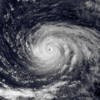



- …that the Joint Typhoon Warning Center considers that Typhoon Vera (pictured) of 1986 is actually two distinct systems, formed from two separated low-level circulations?
- …that Cyclone Freddy (track pictured) in 2023 was the longest-lasting tropical cyclone worldwide?
- …that Cyclone Raquel (track pictured) travelled between the Australian and South Pacific basins between the 2014–15 and 2015–16 seasons, spanning both seasons in both basins?
- …that Hurricane Otis (pictured) in 2023 was the first Pacific hurricane to make landfall at Category 5 intensity and surpassed Hurricane Patricia as the strongest landfalling Pacific hurricane on record?
General images -

From 1975 to 1999, 83 Atlantic hurricanes have affected the U.S. state of Florida. Collectively, tropical cyclones in Florida during the time period resulted in at least $45 billion (2008 USD) in damage, primarily from Hurricane Andrew. Additionally, tropical cyclones in Florida were directly responsible for 54 fatalities during the period. Several tropical cyclones produced over 20 inches (510 mm) of rainfall in the state, including Hurricane Georges which is the highest total during the time period. The 1985 season was the year with the most tropical cyclones affecting the state, with a total of eight systems. Every year included at least one tropical cyclone affecting the state.
The strongest hurricane to hit the state during the time period was Hurricane Andrew, which was one of only four Category 5 hurricanes to strike the United States. Andrew, at the time, was the costliest tropical cyclone in United States history. Additionally, Hurricane Eloise and Hurricane Opal hit the state as major hurricanes.
(Full article...)Topics
Subcategories
Related WikiProjects
WikiProject Tropical cyclones is the central point of coordination for Wikipedia's coverage of tropical cyclones. Feel free to help!
WikiProject Weather is the main center point of coordination for Wikipedia's coverage of meteorology in general, and the parent project of WikiProject Tropical cyclones. Three other branches of WikiProject Weather in particular share significant overlaps with WikiProject Tropical cyclones:
- The Non-tropical storms task force coordinates most of Wikipedia's coverage on extratropical cyclones, which tropical cyclones often transition into near the end of their lifespan.
- The Floods task force takes on the scope of flooding events all over the world, with rainfall from tropical cyclones a significant factor in many of them.
- WikiProject Severe weather documents the effects of extreme weather such as tornadoes, which landfalling tropical cyclones can produce.
Things you can do
 |
Here are some tasks awaiting attention:
|
Wikimedia
The following Wikimedia Foundation sister projects provide more on this subject:
-
Commons
Free media repository -
Wikibooks
Free textbooks and manuals -
Wikidata
Free knowledge base -
Wikinews
Free-content news -
Wikiquote
Collection of quotations -
Wikisource
Free-content library -
Wikiversity
Free learning tools -
Wikivoyage
Free travel guide -
Wiktionary
Dictionary and thesaurus


